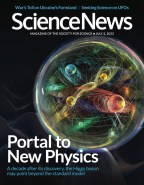Readers ask about the Higgs boson, 10 years after its discovery
- More than 2 years ago

Higgs boson Q&A
The discovery of the Higgs boson filled in a missing piece of the standard model of particle physics, which describes matter and its interactions. A decade later, physicists continue to probe the particle for clues to some of the universe’s biggest questions, Emily Conover reported in “The Higgs boson at 10” (SN: 7/2/22, p. 18).
Conover’s tale of the Higgs boson thrilled physics enthusiasts, inspiring many comments and questions. In the piece, she explained that a Higgs boson is a wave in the Higgs field, an invisible property that pervades the cosmos. When elementary particles interact with the field, they gain mass. More massive particles interact more strongly with the field. Reader Lewis Holcombe wanted to know if elementary particles have zero mass before they interact with the field.
That’s exactly the idea, Conover says. “In the early moments of the universe, before the Higgs field ‘turned on,’ all the fundamental particles were massless,” she says. “But the standard model doesn’t explain why different particles interact with the Higgs field by the amounts they do, and thus have the masses we measure.”
Since the Higgs field imparts mass, reader Paul Leonard wondered if the field also is responsible for gravity.
The Higgs field is not responsible for gravity, Conover says. Although mass and gravity are related, they are different concepts. “Gravity is not part of the standard model,” she says. “We don’t have a working theory of gravity at the particle physics level yet.”
In the standard model, forces are transmitted by particles. Scientists think that there exists another particle, not included in the standard model, called a graviton, which transmits gravity, Conover says. If it exists, the graviton is expected to be a massless particle with no electric charge. But it will be extremely difficult to find, she says, because gravity is very weak compared with the standard model forces: electromagnetism, the weak force and the strong force.
Reader Brad Ruben wondered about other standard model particles: quarks. A top quark is about as heavy as a gold atom. That large mass is reflected in measurements of the particle’s interactions with the Higgs field, Conover reported. Since quarks make up protons and neutrons, which are the building blocks of atoms, Ruben asked how a single quark can weigh as much as an atom.
The top quark’s mass is no contradiction, Conover says. According to the simplest image of protons’ and neutrons’ innards, the particles don’t contain top quarks. Protons are made up of two up quarks and one down quark, whereas neutrons have two down quarks and one up quark, she says. A closer look reveals a more complex image. “For instance, inside the proton, there are not only quarks, but also gluons. These are massless particles that carry the strong force, which ‘glues’ the quarks together,” Conover says. “There is also a ‘sea’ of various types of quarks and antiquarks that last only for brief instants in the proton.” The energies and other subtle properties of these subatomic particles all contribute to the mass of the proton.
Tech takes time
Lightweight subatomic particles called neutrinos could help monitor nuclear submarines to ensure that the uranium-rich fuel many use isn’t weaponized, Emily Conover reported in “Neutrinos could spy nuclear rogues” (SN: 7/2/22, p. 12).
Reader John Oxman asked how useful this monitoring technology would be, considering all countries that currently have nuclear submarines already possess nuclear weapons. Non-nuclear weapon states could get nuclear submarines in the future, Conover says. For example, Australia is set to acquire such subs with the help of the United States and the United Kingdom. “Even if the need for this type of monitoring is not immediate, the process of implementing and perfecting monitoring technologies, especially a new type that uses neutrinos, is very lengthy,” she says. “For such a technology to be useful, researchers have to anticipate the need well in advance.”